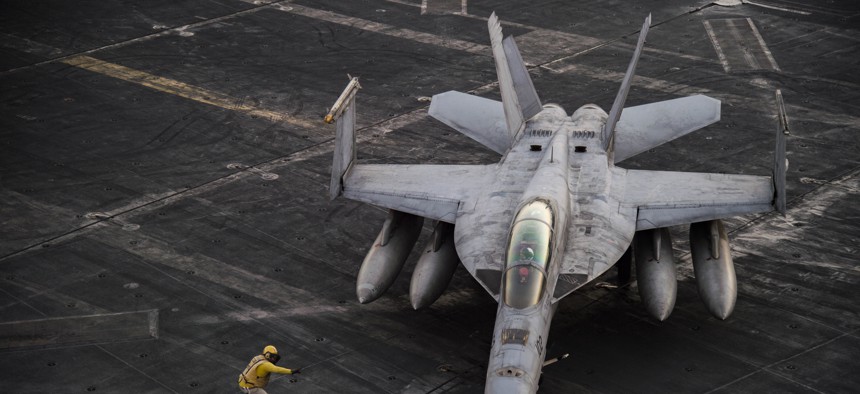
An F/A-18F Super Hornet deployed as part of Operation Inherent Resolve taxis across the flight deck the aircraft carrier USS Dwight D. Eisenhower. U.S. Navy, Petty Officer 3rd Class Nathan T. Beard
Canada Ditches the F-35 for the Super Hornet — For Now
After an initial buy of F/A-18s, Justin Trudeau’s government will hold a competition to replace the rest of its CF-18 Hornets.
Canada intends to begin replacing its aging CF-18 Hornet fighter jets with a batch of Boeing F/A-18 Super Hornets — while Lockheed Martin’s F-35 Joint Strike Fighter, once slated to replace the entire CF-18 fleet, will have to win a new competition to get any contracts at all.
The Liberal government is in negotiations with Boeing to buy what it is calling an “interim fleet” of 18 Super Hornets, Defence Minister Harjit Sajjan told reporters Tuesday at a press conference in Ottawa.
“The interim fleet provides the most effective way forward to help ensure Canada remains a credible and dependable ally,” Sajjan said.
At the same time, Canada will soon begin a “wide-open-and-transparent competition to replace the CF-18 fleet,” Sajjan said.
The competition will begin after Canada’s broad-ranging defense policy review wraps up early next year, he said.
In that contest, the F-35 could still emerge victorious.
“Although disappointed with this decision, we remain confident the F-35 is the best solution to meet Canada’s operational requirements at the most affordable price, and the F-35 has proven in all competitions to be lower in cost than 4th-generation competitors,” Lockheed spokesman Michael Rein said in an email. “The F-35 is combat-ready and available today to meet Canada’s needs for the next 40 years.”
Just the initial 18 planes would be a major score for Boeing. This prospective deal, along with the State Department approving the sale of up to 40 planes to Kuwait, would likely delay the looming end of Super Hornet production.
The interim purchase will require the Royal Canadian Air Force to buy parts and equipment for the F/A-18, which could give the plane a leg up in the coming competition. But the F-35 could still find itself in a good spot, since it boasts stealth and more sophisticated sensors and electronics. Manufacturing will also be ramping up, giving Lockheed more time to work out the remaining production kinks.
Just 77 of Canada’s original 138 CF-18s are still flying after three decades of operation. They fly NORAD air policing missions and have bombed Islamic State militants in the Middle East.
Canada has been a partner on the F-35 program since 2002 and had planned to buy 60 jets to replace the CF-18. During elections last year, Prime Minister Justin Trudeau’s Liberal party said it favored aircraft that could defend Canada, not function as a first-strike aircraft.
NEXT STORY: How to Get the Market to Make Secure IoT Devices
